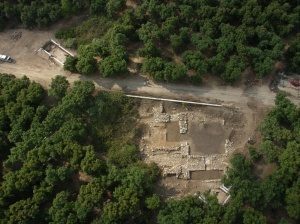
There is no question that the ancient Levant could be described as a major crossroads of civilization. Over and over again, dig sites throughout Israel, Jordan, Lebanon and Syria have turned up artifacts left by the armies and settlers of one empire after another. Through this interview conducted by Popular Archaeology Magazine, Dr. Eric H. Cline, Co-Director of excavations at the site of Tel Kabri in northwest Israel, explains why this site stands out from the rest. The unfolding story of investigations at this site continue to intrigue scholars and the public alike………..
Q: What brought your attention to this site [Tel Kabri] in the beginning?
A: I became involved because of its international relations 3,700 years ago. That’s my professional interest — international relations in the ancient world, particularly between Greece and the Near East. Kabri, which is a Canaanite palace, has Minoan wall and floor paintings in it. So I was intrigued by the question: Why would a Canaanite ruler have a Minoan artist painting his walls and floors? And is there any evidence that there were Minoans living at the site, or Cycladic artisans, and what does it say about the ancient world?
We already knew about this site because Kabri had been excavated before by Kempinski and Niemeier from 1986 to 1993, and they found a painted floor and about 2,000 fragments of painted plaster.
Q: Were they [the painted floor and fragments] recognized as possibly Minoan or Aegean at the time of the discovery?
A: Yes, absolutely. Niemeir [an expert in identifying Aegean/Minoan artwork] joined the project back then when they started to find these things, but their project was over in 1993 and the site then lay unexcavated.
Assaf Yassur-Landau, the excavation Co-Director, excavated there as a volunteer in 1990 and thought at the time that he wanted to come back and dig there himself. We [ Assaf and I] were both excavating at Megiddo, so we knew each other. He did some preliminary testing at Kabri in 2003 with some geophysical equipment and saw indications that the palace was perhaps as much as twice as big as Kempinski and Niemeier thought. So when I ran into him in 2004 he asked if I wanted to re-open the excavations at Kabri with him. I said yes. In 2005 we did a very preliminary season of excavations just to see if the geophysical indications were correct: Was the palace realy twice as big? And was there anything worth a new multi-season excavation? During the excavations, we found walls and floors at a good distance from the previous excavations. So the answer to both questions was yes.
Before we really started to do any digging we needed to do a regional survey of the area. In 2006 and 2007 we surveyed what we thought would have been the kingdom of Kabri and came up with some interesting data that indicated that it was probably a fairly large [Canaanite] kingdom, but that it only lasted for about 250 years. It apparently had a meteoric rise and just as meteoric a fall after the palace was destroyed by unknown people.
Q: Were the Aegean/Minoan paintings discovered previously by Kempinski and Niemeier dated to that 250-year time period?
A: Yes. The palace was only occupied for about 250 years and it goes through about four phases. It looks like the paintings date to one of the middle phases. We believe they were up on the wall and on the floor, and then they were torn down during a renovation phase before the palace was destroyed. It seems that somebody liked them so they put them up. Then somebody didn’t like them and they took them down. Or they may have simply fallen off.
It should be noted that there are only four other places [archaeological sites] in the Near East that have these kinds of paintings. One is Kabri, the only one in Israel. Another is Tel Dab’a in Egypt, and then in Turkey there is Alalakh which Sir Leonard Woolley excavated. Finally there is Qatna in Syria, which is being excavated right now by a German/Italian/Syrian team.
Q: How does the Canaanite structure at Tel Kabri compare to the Canaanite structure found at Hazor, considered the largest known Canaanite site?
A: The one at Hazor is larger. In terms of size, Kabri is about the third largest in all of Israel. But it is dated only to the Middle Bronze period.
We also have an interesting situation where the excavations at Hazor have shown that the temples for the same time period show a Syro-Mesopotamian influence. But Kabri appears to show a Western influence. We have published two articles attempting to explain that. The answer, we think, may be as simple as the fact that Hazor was larger and wealthier and could afford the goods and services from Mesopotamia. Perhaps Kabri could not afford that, so it looked elsewhere for innovation. Perhaps artisans from the Cyclades were cheaper. During our excavations in 2009 we found 100 more pieces of plaster at the site supporting this view to add to the Kempinski/Niemeier record. Sixty of these were painted fresco pieces.
Q: You went back to the site in December 2009/January 2010 to excavate. What emerged from that excavation?
A: There is a certain feature at Kabri that the previous excavators [Kempinski and Niemeier] had uncovered. They suggested that it was the bottom of a staircase. When we started excavating there, it became clear that it was not a staircase. It was a plastered corridor. In 2008 we started digging just to the east of it and we found what looked like a drain connected to it. So in the summer of 2009 we started excavating more to find out why there was a drain associated with it. It turned out that plaster, which is of the same time period as the painted floors, was on top of this ancient corridor. The corridor had pottery in it, strewn all at one depth, as if something sudden had happened. 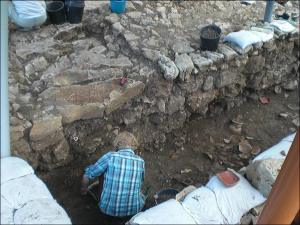 In the side of the corridor, hidden in the wall, was at least one entrance and perhaps as many as three entrances. One of the entrances had a cracked block that, had we been excavating in Greece, I would have said it was the lintel block to the entrance to a tomb. So we could see this cracked block with soil beneath it, in what was otherwise a solid stone wall. Next to it was another faint outline where the stones looked like they were horizontal and vertical, indicating the possibility of a blocked opening in the wall, and then another one [blocked opening] on the other side, as well. We didn’t know what this was. But it was in the middle of the palace, it was a hidden entrance in a wall, which one could not have seen unless one was actually in there. This was interesting because at the site of Qatna in Syria they had just found similar openings in their palace. Those openings led to a royal tomb.
In the side of the corridor, hidden in the wall, was at least one entrance and perhaps as many as three entrances. One of the entrances had a cracked block that, had we been excavating in Greece, I would have said it was the lintel block to the entrance to a tomb. So we could see this cracked block with soil beneath it, in what was otherwise a solid stone wall. Next to it was another faint outline where the stones looked like they were horizontal and vertical, indicating the possibility of a blocked opening in the wall, and then another one [blocked opening] on the other side, as well. We didn’t know what this was. But it was in the middle of the palace, it was a hidden entrance in a wall, which one could not have seen unless one was actually in there. This was interesting because at the site of Qatna in Syria they had just found similar openings in their palace. Those openings led to a royal tomb.
In December 2009/January 2010 we returned to conduct some additional probes. We took the top off of the associated wall, and found that the lintel block was just the first of seven. We could see that what we really had was a corbeled passageway that went directly through the wall. It was a hidden passageway, but it didn’t lead to a tomb as at Qatna. It led into a room that we didn’t know existed, either in another part of the palace or outside the palace. The room to which it led is plastered with a very thick floor and the pottery there in that stratigraphy pushed the dating of the palace back by another 50 years. It was an earlier part of the palace. And although we had not found the entrance to a tomb [as at Qatna], we found something very peculiar, as it is a secret passageway made through a wall in the basement of the palace. We think it could have been a sally port [a secret back entrance] so that if the enemy is attacking the front gate, for example, defenders within the palace can go out the sally port at the back and come back around and destroy the attacking enemy. Or, as a subterranean way to get from one part of the palace to another, could it have been used for secret purposes? We have no idea.
The pottery in the corridor continues to be a mystery. It was at the entrance to this passageway. Does it represent some sort of ritual? Now we are thinking that when they filled in the corridor and plastered it over, they may have used it as a garbage dump before filling it in and plastering it. We will be investigating that further. So there may be another opening or two, but they are probably not connected to royal tombs.
[Another significant outcome of the December 2009/January 2010 excavations was the discovery that the palace was built some 150 years earlier than previously thought, making it one of the earliest Middle Bronze Age palaces found in Israel to date.]
Q: Getting back to the Aegean-style paintings: We know that the volcanic eruption at Santorini (ancient Thera) ocurred around 1628 B.C.E., and that it may have caused an exodus of people who then spread to other places in the Mediterranean area. Is there any possibility, given your Aegean-style fresco painting findings, that a group of Minoans escaping this eruption may have settled at Kabri?
A: There is no evidence so far that Minoans, or any other Aegean people, such as those in the Cyclades or mainland Greece, migrated to and settled at Kabri as a group. We don’t have enough Minoan pottery to support that. I suspect that, yes, the eruption at Santorini may have caused a migration of people from the island, including artisans who may have painted at Akrotiri or Knossos and were in need of employment, staying at Kabri temporarily. Certainly the paintings at Kabri look an awful lot like the ones on Santorini [ancient Thera]. So it may have been a refugee situation, but that would be mere speculation. The one thing we can support right now is that, if there was a group of Aegean people at Kabri, they were only living there temporarily.
Ancient tablets of Assyrian origin were found at the site of Kanesh in Turkey (ancient Anatolia). Back in the 19th century B.C.E. merchants from Assyria went and lived at Kanesh in Anatolia, trading textiles for silver and tin, and we would never had known that there were Assyrians there, if not for the tablets. The tablets record that they were there. When the Assyrians arrived at Kanesh, they completely adopted the Anatolian ways, so it may be that Minoan people migrated to Kabri and simply adopted Canaanite ways, in which case we would never know that they were there, except for the paintings.
And here is another possibility: The one thing about pushing the timeline of the palace back earlier [as we discovered during the 2009/2010 excavations] is that it is conceivable, pending Carbon 14 datings, that the paintings at Kabri are a little older than we think. It was at one time thought that the paintings were 16th century (B.C.E.). We are now quite sure that they are 17th century. In fact, we think that the paintings we found may possibly be the oldest discovered in the Near East. Any date earlier than the 17th century would suggest that the influence had gone from east to west.
Q: Is there evidence at the site that might support that?
A: No. It is very unlikely that the Kabri frescoes are earlier than the late 17th century, but Sir Leonard Woolley had originally suggested that this technique of painting on fresco came from the East and went west to the Aegean. That was later discounted and determined that it went the other direction. But there is an outside chance that Woolley was right, and I would not rule out the possibility that it started in the East. For example, the inlaid daggers found at Mycenae have also been found elsewhere, and their antecedents are at sites like Byblos in the Near East. The whole idea of inlaid metal is actually eastern that gets taken later to the Aegean. It is therefore possible that the fresco painting technique originated in the East and went west, as well. So there are all kinds of possibilities. And this would apply to explaining the Aegean influence at Kabri.
Q: What is it about the frescoes/paintings that clearly identify them as Aegean or Cycladic in nature?
A: There are a couple of things: One is this whole technique of painting on the plaster wall while it is still wet. That is an Aegean technique. In the Near East, they more often painted after the plaster was dry. Second, there is a technique of using strings to help in the painting process. For example, the Minoans took a string and just tightened it so that it contacted the wet plaster and created a perfectly straight line. We have plaster at Kabri that shows that. The other thing they did was take string and dip it in, for example, red paint, and tighten it quickly against the plaster. The red paint thus makes a perfectly straight line. That is how the floor at Kabri was created. That is a Minoan technique.
Q: Have you found any symbols or designs, things or animals, etc. in the fresco paintings that would tell you that they are Cycladic or Aegean?
A: Yes and no. The first excavators, Kempinski and Niemeier, found a floor with a pattern of red squares with flowers or vegetation in it. There is something that looks like an Iris and other floral motifs — maybe Aegean, maybe not. The 2,000 fresco fragments that they found, when placed together using ancient Santorini artwork as a model, does look very much like the miniature fresco at Santorini. Little pieces that look like ships and other pieces that look like architecture were found. There are a couple of pieces that look like they are part of the wing of a griffin. In one of my lectures where I talk about Aegean style paintings I laugh a bit because other excavators at other sites have found bits and pieces of what they say come from a griffin. So imagine our surprise last season when we came up with 5 or 6 pieces of a fresco that have a deep rich blue background (a typical Aegean-style fresco color that has never been found in Israel before), with a figure in the foreground in white with black outlines (also typically Aegean), and as we are looking at it we are thinking that we have seen this before.
Q: What is it?
A: There are a number of possibilities. One could be the wing of a flying fish, like that found at Melos. It could also be a palm tree. It could be a woman’s white hand, but there are no fingernails. Compared to a griffin piece found at Mycenae, however, there is a close resemblance. We think we may have the wing of a griffin, in which case it is really funny that I have been making fun of everyone else about the griffin interpretation. There are another couple of pieces that add to the interpretation of it as part of a griffin. But the problem is that this griffin image type is dated to the 14th century B.C.E., and we are looking at 17th century fragments. A three-hundred year difference may be a little too large. But if our find is a griffin, it is interesting to note that griffins are in both Near Eastern and Aegean cultures.
These fresco finds have told us something else that is important, however. Where we found them, and this is where it gets very interesting, was nowhere near where the original excavators [Kempinski and Niemeier] found theirs, so we are in a totally separate part of the palace. Their fragments were found used as packing material underneath a threshold. Ours were found face down on a white plaster floor and the only way that we realized they were there was when we were cleaning the floor. A white piece would pop up. And as we turned the white piece over to reveal the colored front, we could see that our wall painting had been ripped off the wall anciently and then used to patch the floor. And our wall fragments are completely different from the fragments that they found. Ours are in a different scale. This means we have a second wall painting. As we excavated the squares, we could see that one of these pieces was part-way into a balk [a section of an area that is left un-excavated for stratigraphic and other purposes], so we know that when we go back and take out that balk, there will be more pieces. There were also more pieces found to the east, and we did not excavate the square to the east. So we have high hopes that we will find more wall fresco fragments. Moreover, one of the fragments was thicker than the others, which indicates that it was not a part of a wall. It must have been part of a floor. The original painted floor that Kempinski and Niemeier excavated is not missing any pieces, so our piece must be from another floor from somewhere else in the palace, reused as a patching piece on another [unpainted] floor. We are now looking for that other floor.
It is interesting to note that their [Kempinski and Niemeier’s] floor and wall painting discoveries and our floor and wall painting discoveries date from the same phase. So did some artist come and say, “Hey, I can redo your palace for you.” Or, was there a succeeding king who wanted to redo it all? We think there may be a whole Aegean theme throughout the whole palace. Perhaps in this other part of the palace it is not as grand as in the first part. And, It may be that we will find Minoan pottery or other evidence of them actually being there. Answers to these questions await further excavation.
________________________________________________
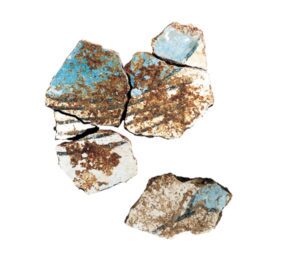
Painted fresco fragments excavated at Tel Kabri. Courtesy Tel Kabri Excavations.
________________________________________________
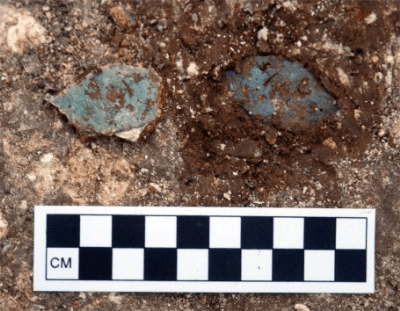 Painted fresco fragments excavated at Tel Kabri. Courtesy Tel Kabri Excavations.
Painted fresco fragments excavated at Tel Kabri. Courtesy Tel Kabri Excavations.
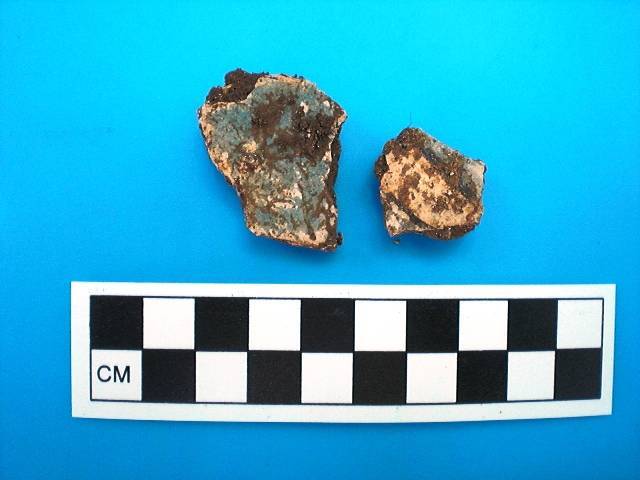 Painted fresco fragments excavated at Tel Kabri. Courtesy Tel Kabri Excavations.
Painted fresco fragments excavated at Tel Kabri. Courtesy Tel Kabri Excavations.
________________________________________
Q: Based on what you have done so far, and your idea of how big this palace might be, what percentage would you say has been excavated thus far?
A: Hard to say, until we find the limits. We found what we believe is the northern or enclosing wall, and a very strange road or walkway adjacent to it on the outside, so we know how far it goes on the north. We are not yet sure how far it extends on the east, nor do we know how far it extends on the south. We think we know how far it is to the west, and we are looking for that because that should be the entrance. So, because we don’t know how big it is, we can’t guess how much we’ve excavated. But I would be surprised if we have excavated any more than 10 to 20% of the palace site. There is a lot more to do. And based on what they are finding at Qatna, which has similar dates, I think we still have some very interesting things to find, especially because our palace, like that at Qatna, ended in a fiery destruction. We may find some very interesting things that got caught in that destruction. So what was horrible for them may be a bonanza for us, and I think we have only begun to scratch the surface on the palace.
Then there is the rest of the site aside from the palace. We have not yet touched the fortifications. It had a huge mudbrick set of fortifications. Up on the acropolis of the mound, previous excavators have found evidence of Greek mercenaries from the Iron Age. The palace part was basically abandoned until the Iron Age and then it is only inhabited sporadically in our area. So at some point we want to go up and investigate the acropolis portion of the mound where they have found evidence for the presence of Greek mercenaries. Think of the coincidence — or is it a coincidence — that in the Middle Bronze Age we have Minoans painting the palace and then in the Iron Age we have Greek mercenaries at the site. What is it about Kabri that the Greeks or Aegeans like so much?
The other question I have is this: If this site was inhabited in the Middle Bronze Age and the Iron Age, why isn’t it inhabited in the Late Bronze Age, when there was so much contact with and influence from the Myceneans in this part of the world?
Kabri is like no other site I have ever investigated, because it is so huge and because it was only occupied during the Middle Bronze Age, with a puzzling absence of occupation and then suddenly an Iron Age presence on the acropolis.
Q: Do you think the MB palace at Kabri is considerably larger than the same at Megiddo?
A: Yes, the palace is probably larger than the one at Megiddo. But it depends upon what period we are talking about. For the Middle Bronze period, it is probably larger. It is interesting because when you are driving to the site, there is a little bump in the road, and that means you have just driven over the fortifications. So the palace, including the fortifications, is huge.
Q: What are your plans for this coming dig season?
A: We want to reconstruct the history of the palace. If we can reconstruct the life-cycle of the palace in its 250-year history, including evidence of feasting and things like that, that would be good. Along the way, if we should happen to find more painted frescoes, then that would also be very good, and we are anticipating that we will find more. If we are able to investigate the other features in that mysterious corridor, that would be a plus, and we are planning to do that. And then, as I mentioned, outside the northern wall we see this very strange, intriguing stone feature that is only one level of stones thick. 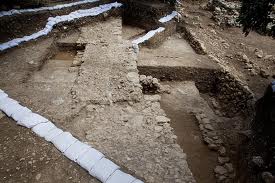 It zigzags, which is usually seen on Crete. It is either a walkway or the bottom of a wall. If it is a wall, then it is a protective wall going around the palace. I think it is a roadway and that the road may well be extending around the palace. A similar roadway can be found at Knossos and elsewhere. If it is a roadway, and this is the northern perimeter of the palace, and the entrance is on the west, then what we see may indeed be turning a corner and headed to the entrance. So if we continue to excavate in that direction this coming season, it may lead us to the missing entrance to the palace.
It zigzags, which is usually seen on Crete. It is either a walkway or the bottom of a wall. If it is a wall, then it is a protective wall going around the palace. I think it is a roadway and that the road may well be extending around the palace. A similar roadway can be found at Knossos and elsewhere. If it is a roadway, and this is the northern perimeter of the palace, and the entrance is on the west, then what we see may indeed be turning a corner and headed to the entrance. So if we continue to excavate in that direction this coming season, it may lead us to the missing entrance to the palace.
So what we are basically doing is making sure we understand not just the history of the palace but also its size and what is immediately happening outside of it.
To summarize, the coming season should help us understand a bit more about the history, life-cycle and size of the palace, as well as uncover more painted plaster and define what is going on with the mysterious corridor. We also hope to see what is going on just outside the palace with the roadway or wall feature and whether or not we can locate the missing entrance. All of these things will also hopefully give us more insight into what is happening inside the palace.
All in all, even though what we are doing is supplementing and expanding upon what the previous excavators have done, it turns out that there is much more to investigate than previously thought.
*Courtesy Tel Kabri Excavations.
Top Cover Photo: Aerial view of Tel Kabri. Courtesy Tel Kabri Excavations.
Second photo from top: Excavating the corridor feature of the Middle Bronze Age Palace. Courtesy Tel Kabri Excavations.
Eighth photo from top: The curious “zigzag” structure excavated at Tel Kabri. Courtesy Tel Kabri Excavations.
________________________________________________________________________________________________________________________
About Eric Cline
Dr. Eric H. Cline, a former Fulbright scholar, is an award-winning author, teacher, and advisor with degrees in Classical Archaeology, Near Eastern Archaeology, and Ancient History from Dartmouth College (1982), Yale University (1984), and the University of Pennsylvania (1991) respectively. He currently serves as Chair of the Department of Classical and Near Eastern Languages and Civilizations at the George Washington University in Washington, D.C.
Dr. Cline’s primary fields of study are the military history of the Mediterranean world from antiquity to present and the international connections between Greece, Egypt, and the Near East during the Late Bronze Age (1700-1100 BCE). He is an experienced field archaeologist, with 28 seasons of excavation and survey to his credit since 1980. He has worked in Israel, Egypt, Jordan, Cyprus, Greece, Crete, and the United States, including eight seasons at the site of Megiddo (biblical Armageddon) in Israel, where he is currently the Associate Director (USA). He is also Co-Director of the new series of archaeological excavations at the site of Tel Kabri, also located in Israel.
A prolific researcher and author with ten books and nearly 100 articles to his credit, Dr. Cline is perhaps best known for his book, The Battles of Armageddon: Megiddo and the Jezreel Valley from the Bronze Age to the Nuclear Age (Ann Arbor 2000; paperback 2002), which received the 2001 Biblical Archaeology Society (BAS) Publication Award for “Best Popular Book on Archaeology,” was a Main Selection of the Natural Science Book Club, sold out its first printing in less than four months, and has now been translated and published into Croatian (2005).
Dr. Cline has been interviewed by syndicated national and international television and radio hosts including Robin Roberts and George Stephanopoulos on ABC’s “Good Morning America,” Bill Hemmer and Martha MacCallum on Fox New Channel’s “America’s Newsroom,” Fergus Nicoll on the BBC World Service/The World Today, Kojo Nnamdi on NPR’s “Public Interest” show, Michael Dresser on “The Michael Dresser” show, and Richard Sheehe on WRGW.
Born in Washington, DC (at GWU Hospital) and raised in California (San Francisco and Los Angeles), Dr. Cline is married and has several children, two cats, and varying numbers of fish.




